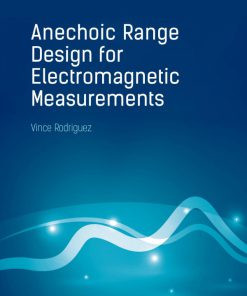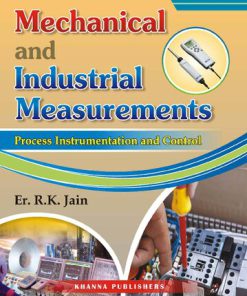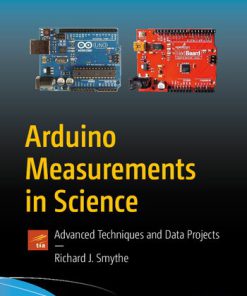Theory and Design for Mechanical Measurements 7th Edition by Richard Figliola, Donald Beasley 1119475651 9781119475651
$50.00 Original price was: $50.00.$25.00Current price is: $25.00.
Theory and Design for Mechanical Measurements 7th Edition by Richard Figliola, Donald Beasley – Ebook PDF Instant Download/Delivery: 1119475651, 9781119475651
Full download Theory and Design for Mechanical Measurements 7th Edition after payment
Product details:
ISBN 10: 1119475651
ISBN 13: 9781119475651
Author: Richard S. Figliola; Donald E. Beasley
Theory and Design for Mechanical Measurements merges time-tested pedagogy with current technology to deliver an immersive, accessible resource for both students and practicing engineers. Emphasizing statistics and uncertainty analysis with topical integration throughout, this book establishes a strong foundation in measurement theory while leveraging the e-book format to increase student engagement with interactive problems, electronic data sets, and more. This new Seventh edition has been updated with new practice problems, electronically accessible solutions, and dedicated Instructor Problems that ease course planning and assessment.
Extensive coverage of device selection, test procedures, measurement system performance, and result reporting and analysis sets the field for generalized understanding, while practical discussion of data acquisition hardware, infrared imaging, and other current technologies demonstrate real-world methods and techniques. Designed to align with a variety of undergraduate course structures, this unique text offers a highly flexible pedagogical framework while remaining rigorous enough for use in graduate studies, independent study, or professional reference.
Theory and Design for Mechanical Measurements 7th Table of contents:
1 Basic Concepts of Measurement Methods
Problems
Readings
1.1 Introduction
1.2 General Measurement System
1.3 Experimental Test Plan
1.4 Calibration
1.5 Standards
1.6 Presenting Data
SUMMARY
NOMENCLATURE
REFERENCES
2 Static and Dynamic Characteristics of Signals
Problems
Readings
2.1 Introduction
2.2 Input/Output Signal Concepts
2.3 Signal Analysis
2.4 Signal Amplitude and Frequency
2.5 Fourier Transform and the Frequency Spectrum
SUMMARY
REFERENCES
SUGGESTED READING
NOMENCLATURE
3 Measurement System Behavior
Problems
Readings
3.1 Introduction
3.2 General Model for a Measurement System
3.3 Special Cases of the General System Model
3.4 Transfer Functions
3.5 Phase Linearity
3.6 Multiple‐Function Inputs
3.7 Coupled Systems
3.8 Summary
REFERENCES
NOMENCLATURE
4 Probability and Statistics
Problems
Readings
4.1 Introduction
4.2 Statistical Measurement Theory
4.3 Describing the Behavior of a Population
4.4 Statistics of Finite‐Sized Data Sets
4.5 Hypothesis Testing
4.6 Chi‐Squared Distribution
4.7 Regression Analysis
4.8 Data Outlier Detection
4.9 Number of Measurements Required
4.10 Monte Carlo Simulations
SUMMARY
REFERENCES
NOMENCLATURE
5 Uncertainty Analysis
Problems
Readings
5.1 Introduction
5.2 Measurement Errors
5.3 Design‐Stage Uncertainty Analysis
5.4 Identifying Error Sources
5.5 Systematic and Random Errors and Standard Uncertainties
5.6 Uncertainty Analysis: Multi‐Variable Error Propagation
5.7 Advanced‐Stage Uncertainty Analysis
5.8 Multiple‐Measurement Uncertainty Analysis
5.9 Correction for Correlated Errors
5.10 Nonsymmetrical Systematic Uncertainty Interval
SUMMARY
REFERENCES
NOMENCLATURE
6 Analog Electrical Devices and Measurements
Problems
Readings
6.1 Introduction
6.2 Analog Devices: Current Measurements
6.3 Analog Devices: Voltage Measurements
6.4 Analog Devices: Resistance Measurements
6.5 Loading Errors and Impedance Matching
6.6 Analog Signal Conditioning: Amplifiers
6.7 Analog Signal Conditioning: Special-Purpose Circuits
6.8 Analog Signal Conditioning: Filters
6.9 Grounds, Shielding, and Connecting Wires
SUMMARY
REFERENCES
NOMENCLATURE
7 Sampling, Digital Devices, and Data Acquisition
Problems
Readings
7.1 Introduction
7.2 Sampling Concepts
7.3 Digital Devices: Bits and Words
7.4 Transmitting Digital Numbers: High and Low Signals
7.5 Voltage Measurements
7.6 Data Acquisition Systems
7.7 Data Acquisition System Components
7.8 Analog Input–Output Communication
7.9 Digital Input–Output Communication
7.10 Digital Image Acquisition and Processing
SUMMARY
REFERENCES
NOMENCLATURE
8 Temperature Measurements
Problems
Readings
8.1 Introduction
8.2 Temperature Standards and Definition
8.3 Thermometry Based on Thermal Expansion
8.4 Electrical Resistance Thermometry
8.5 Thermoelectric Temperature Measurement
8.6 Radiative Temperature Measurements
8.7 Physical Errors in Temperature Measurement
SUMMARY
REFERENCES
SUGGESTED READING
NOMENCLATURE
9 Pressure and Velocity Measurements
Problems
Readings
9.1 Introduction
9.2 Pressure Concepts
9.3 Pressure Reference Instruments
9.4 Pressure Transducers
9.5 Pressure Transducer Calibration
9.6 Pressure Measurements in Moving Fluids
9.7 Modeling Pressure–Fluid Systems
9.8 Design and Installation: Transmission Effects
9.9 Acoustical Measurements
9.10 Fluid Velocity Measuring Systems
SUMMARY
REFERENCES
NOMENCLATURE
10 Flow Measurements
Problems
Readings
10.1 Introduction
10.2 Historical Background
10.3 Flow Rate Concepts
10.4 Volume Flow Rate through Velocity Determination
10.5 Pressure Differential Meters
10.6 Insertion Volume Flow Meters
10.7 Mass Flow Meters
10.8 Flow Meter Calibration and Standards
10.9 Estimating Standard Flow Rate
SUMMARY
REFERENCES
NOMENCLATURE
11 Strain Measurement
Problems
Readings
11.1 Introduction
11.2 Stress and Strain
11.3 Resistance Strain Gauges
11.4 Strain Gauge Electrical Circuits
11.5 Practical Considerations for Strain Measurement
11.6 Apparent Strain and Temperature Compensation
11.7 Optical Strain Measuring Techniques
SUMMARY
REFERENCES
NOMENCLATURE
12 Mechatronics: Sensors, Actuators, and Controls1: Sensors, Actuators, and Controls
Problems
Readings
12.1 Introduction
12.2 Sensors
12.3 Actuators
12.4 Controls
SUMMARY
REFERENCES
NOMENCLATURE
A PROPERTY DATA AND CONVERSION FACTORS
B LAPLACE TRANSFORM BASICS
B.1 Final Value Theorem
B.2 Laplace Transform Pairs
REFERENCE
GLOSSARY
INDEX
END USER LICENSE AGREEMENT
People also search for Theory and Design for Mechanical Measurements 7th:
figliola and beasley theory and design for mechanical measurements pdf
mechanical dimensions
basic mechanical design calculations
b type pulley dimensions
Tags:
Richard Figliola,Donald Beasley,Theory
You may also like…
Engineering - Mechanical Engineering & Dynamics
Shigley’s Mechanical Engineering Design in SI Units (11th Ed.) 11th Edition Richard Budynas
Business & Economics - Management & Leadership
Engineering - Mechanical Engineering & Dynamics
Engineering - Mechanical Engineering & Dynamics
Geometric Dimensioning and Tolerancing for Mechanical Design, 3E 3rd Edition Gene R. Cogorno
Engineering - Engineering Technology
Mechanical and industrial measurements 3rd Edition R. K. Jain
Engineering - Electrical & Electronic Engineering
Engineering - Mechanical Engineering & Dynamics
Design Data Handbook for Mechanical Engineering in SI and Metric Units K. Mahadevan












